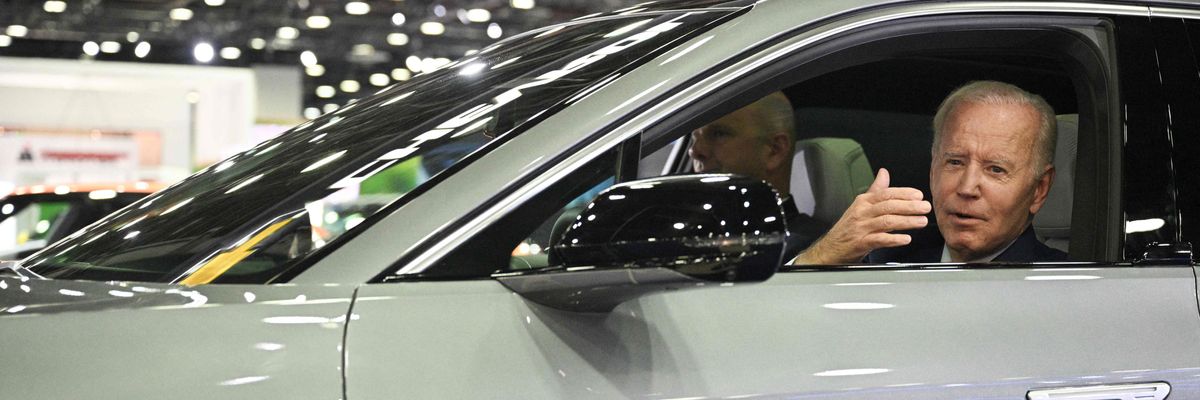The Biden administration received a mixture of praise and criticism from green groups on Wednesday after the Environmental Protection Agency unveiled new tailpipe pollution standards for passenger cars and light-duty trucks.
The finalized rules were simultaneously described as the strongest ever of their kind and a disappointing step backward compared to the EPA's original proposal and what experts say is possible—and necessary—to combat the climate crisis.
The new tailpipe standards would strengthen emissions limits more slowly than the EPA's original proposal, which came under fire from the auto industry and Big Oil. The American Fuel and Petrochemical Manufacturers (AFPM) falsely claimed the EPA's proposed standards amounted to an effort to "ban new gas, diesel, and flex-fuel vehicles from the U.S. market."
AFPM and the American Petroleum Institute threatened to challenge the finalized standards in court.
As The New York Timesreported Wednesday, the finalized rule "does not mandate the sales of electric vehicles, and gas-powered cars and trucks could still be sold."
"Rather," the Times explained, "it requires carmakers to meet tough new average emissions limits across their entire product line. It's up to the manufacturers to decide how to comply... EPA officials said automakers could comply with the emissions caps by selling a mix of conventional gasoline-burning cars, hybrids, electric vehicles, or other types of vehicles, such as cars powered by hydrogen."
Dan Becker, director of the Center for Biological Diversity's Safe Climate Transport Campaign, said in a statement that "this rule could've been the biggest single step of any nation on climate, but the EPA caved to pressure from Big Auto, Big Oil, and car dealers and riddled the plan with loopholes big enough to drive a Ford F-150 through."
"In exchange for making EVs, the rule allows automakers to produce tens of millions of new gas-guzzlers with few or no carbon cuts," said Becker. "These cars, SUVs, and pickups will dominate sales through much of this decade, guzzling and polluting into the middle of the century."
"It made improvements but is coming up well short, which is deeply disappointing at a time when we need ever-stronger climate leadership."
Public Citizen also accused the Biden EPA of weakening the vehicle emissions standards to appease the auto industry. One industry trade group, Alliance for Automotive Innovation, applauded the administration for "moderating the pace of EV adoption in 2027, 2028, 2029, and 2030."
Chelsea Hodgkins, a senior policy advocate for Public Citizen, said that while "more vehicle pollution will be avoided and more lives saved" under the new rules "than would have been under current regulations," the EPA's new standards fall "far short of what is needed to protect public health and our planet."
"We are in a crisis, and clean vehicle technology that will help solve it is here and available now," said Hodgkins. "The Biden administration had the opportunity to shift the automotive industry away from a model that's driving record profits for automakers while literally killing us, toward one that still provides strong profits but keeps the world safer for humans. It made improvements but is coming up well short, which is deeply disappointing at a time when we need ever-stronger climate leadership."
Transportation is the largest single source of air pollution in the U.S., spewing benzene and other toxins into the environment to the detriment of the climate and public health.
The EPA estimates its standards would help the U.S. avoid more than 7 billion tons of carbon emissions and reap $13 billion worth of public health benefits "due to improved air quality."
Steven Higashide, director of the Clean Transportation Program at the Union of Concerned Scientists, described the EPA's new rules as "the strongest standards ever finalized and vital for meeting U.S. climate goals" and said they would "shift the trajectory of the automobile market and put us on a path to real emissions reductions."
"However, EPA should have gone even further because we have the technology to be more ambitious," said Higashide. "The science is clear on both the urgent need to cut climate-endangering emissions and the fact that we can make the cuts we need. We don't have many opportunities to reduce transportation pollution and it's disappointing that this rule falls short of what's possible. We'll continue to push the administration to create, implement, and enforce the strongest rules possible."
The EPA unveiled its finalized standards weeks after the agency opted in the face of industry pressure to delay a regulatory crackdown on existing gas-fired power plants, exempting them from a separate anti-pollution rule.
The EPA's moves come during a critical election year in which the presumptive Republican nominee, former President Donald Trump, and his allies are threatening to undo any climate progress the Biden administration makes if they regain power.
A recent analysis by Carbon Brief estimated that a second Trump term would likely result in an additional 4 billion tonnes of carbon dioxide equivalent emissions at a time when quickly slashing planet-warming pollution is necessary to avoid the worst of the climate emergency.
Trump has vowed to roll back the EPA's tailpipe emissions standards on day two of a second term and warned during a campaign rally over the weekend that the reelection of President Joe Biden would mean a "bloodbath" for the U.S. auto industry.
The United Auto Workers, which has endorsed Biden and vocally pushed for a just transition to electric vehicles, welcomed the EPA's new pollution standards on Wednesday, saying the agency "has made significant progress on its final greenhouse gas emissions rule for light-duty vehicles."
The UAW criticized the original proposal and urged the EPA to make changes to "ensure the new rules do not disproportionately impact domestic union auto production."
"By taking seriously the concerns of workers and communities," the union said in a statement Wednesday, "the EPA has come a long way to create a more feasible emissions rule that protects workers building [internal combustion engine] vehicles, while providing a path forward for automakers to implement the full range of automotive technologies to reduce emissions."

